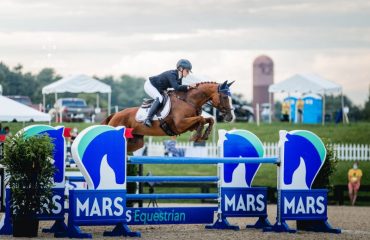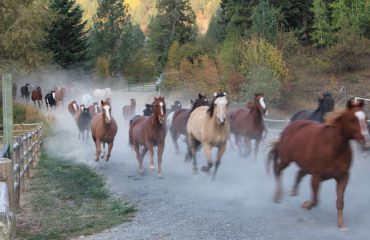By Cheyenne Lord
A lifelong equestrian turned agility addict, Betsie Bolger has always been involved with horses and dogs. She grew up riding her grandparents’ horses whenever she visited their Pennsylvania farm from her home in New Jersey, and she helped her grandmother and cousins raise champion Irish Setters.
“During one visit when I was about 3 years old, I wandered off while I was supposed to be napping,” Betsie said. “My grandfather found me in the back field, hugging one of the horses’ front legs and saying, ‘Nice big doggie!’ Needless to say, dogs and horses have seemed somewhat interchangeable to me right from the start.”
Competing Horses
Betsie, who now lives in Dallas, Texas, started taking formal riding lessons when she turned 6 and became a regular barn rat as soon as she was old enough. She spent most of her summers at a Massachusetts equestrian camp, successfully riding ponies at local shows.
When she was 15, Betsie went on her first A-rated summer circuit with her trainer and Thoroughbred hunter prospect Greeting Card. The pair won several championships in the Intermediate Junior Hunters and qualified for the American Horse Show Association (AHSA, now US Equestrian) Medal Finals at the Pennsylvania National Horse Show.
Betsie’s Junior successes continued when her parents bought Double Take, aka Mini, a Quarter Horse who won the Junior Hunter Championship at the National Horse Show. Betsie and Mini soon began training with George Morris at Hunterdon, focusing on the equitation and Small Junior Hunter divisions.
While riding at Hunterdon, Betsie also competed with her Large Junior Hunter, March On, and Junior Jumper, Y Hugo, who would later become her first Grand Prix horse. She won several major championships, including the Governor’s Cup National Hunt Seat Championship on Double Take, and was the Leading Rider on Y Hugo at the Southampton Classic. 
After aging out of the Junior divisions, Betsie and two of her fellow riders joined George in France in 1978 for what would become the annual Young Riders Tour. Betsie rode aboard Y Hugo and her newly-acquired Conformation Hunter turned jumper, Silver Exchange.
“Competing in Europe was both awesome and eye-opening,” Betsie said. “It took my riding to a whole new level. I won a Six Bar Puissance on Silver Exchange, and when they raised the American flag and played the U.S. National Anthem, it brought me to tears.”
Betsie was long listed for the 1980 U.S. Olympic show jumping team and loaned Silver Exchange to the shortlisted Katie Monahan, another Hunterdon rider in need of a horse. While the U.S. ultimately boycotted the Olympic Games that year, Betsie took a break from riding to finish her last semester of college. She then married and moved to Dallas, to follow her husband’s job.
From Horses to Dogs
Betsie’s career as a Texas riding instructor began after writing “Confessions of an Ex-Show Gypsy” for The Chronicle of the Horse, when a woman who read the article asked if she would teach the Dallas Pony Club. Betsie went on to work at several Dallas equestrian facilities as a professional, including her own Dark Horse Enterprises. After years of training horses and riders for all levels of competition, she had her first encounter with dog agility.
“I arrived at the barn one rainy August day to find the covered arena full of tiny jumps, tunnels and a bunch of weird blue and yellow contraptions,” Betsie said. “The stable owner said, ‘Oh, I forgot to tell you, I rented the arena to the dog agility people for the weekend.’ Since it was raining too hard that day to ride in the outdoor ring, I used the tiny jumps to set horseless horse show courses for the campers.”
 It wasn’t until years later, after Betsie had given up horses to spend time with her second husband, Jon Mott, that she considered trying agility herself. She ran across several YouTube videos of the sport before bringing a Jack Russell/Chihuahua mix named Coco home from the SPCA of Texas.
It wasn’t until years later, after Betsie had given up horses to spend time with her second husband, Jon Mott, that she considered trying agility herself. She ran across several YouTube videos of the sport before bringing a Jack Russell/Chihuahua mix named Coco home from the SPCA of Texas.
“As I watched Coco play with our other dogs, I saw how she loved to run fast and jump over things,” Betsie said. “When she was feeling revved up, she would spontaneously leap and twirl in midair. I thought she might enjoy agility, and I wanted to try it myself, so I started looking for a place to take lessons just for fun. I’d already spent most of my life competing as an equestrian, so I thought, I don’t need that kind of pressure again. Well, I forgot how much I enjoy competing!”
Betsie wasn’t the only local equestrian to join the Center for Canine Sports (CCS) in Garland, Texas. One of the riders she knew from her first barn was pictured on the CCS website, and she later recognized others’ names on the trials’ running orders. Now, she also trains her dogs with former three-day eventer Brenda Kelly.
Betsie was still in the beginner class at CCS teaching Coco how to weave when the Masters trainer, Lisa Jarvis, encouraged her to enter her first trial. Although the event had been scheduled for one Saturday and Sunday at the CCS facility, it was moved to the Lucky Dog Training Center in Tyler, Texas, after two days’ worth of rain prevented CCS from hosting outside. Despite the revised Sunday schedule being packed with classes, Betsie waited the full day for her turn in the ring, telling Lisa and her beginner trainer, Julie Stanek, that she would stay for as long as it took.
Her patience from a history of horse showing paid off. She and Coco earned their first Q in Starters Snooker at the stroke of midnight.
Keep Having Fun
Betsie has not stopped running her dogs since. She currently competes with Steady Teddy, “a four-day foster fail,” and Coco, who is working on her Gold Agility Dog Champion title and recently won her Bronze Lifetime Achievement Award. Another two of Betsie’s six rescue dogs are practicing their foundation work.
“Like horse shows, agility trials are a yardstick by which to measure your progress. And in a sport where the whole point is to make sure your dog has fun, and to have fun alongside your dog, you really can’t lose!” Betsie said.
Betsie’s new, no-pressure outlook on competing stems from that fateful first trial. While Coco balked at entering Lucky Dog’s tunnels during their first Jumpers run, the judge told Betsie to move on and make sure Coco kept having fun. 
“All those years I taught riding, it never occurred to me to tell my students to make sure the horse had fun,” Betsie said. “But looking back, maybe I should have! There’s quite a lot that can be extrapolated from training horses to training dogs—not overdoing it with youngsters, not overjumping at any age, evaluating their conformation and athletic abilities—but, of course, the biggest similarity is that you’re partnered with another sentient, non-human being.”
How can handlers train their dogs to maintain impulsion and stay balanced on their own? Betsie and other current or former equestrians know that gymnastics (gridwork) is the answer. For example, Betsie gives her dogs several days off immediately following a trial before running them over a single low jump or a combination with jump bumps (also known as speed bumps or stride regulators) on each side to get them jumping round again.
“As with horses, dogs jumping flat quickly translates into knocked bars,” Betsie said. “It’s unfortunate when some people aren’t interested in gridwork, because they’re overlooking an excellent ongoing training tool. Cavaletti such as ‘bounce’ jumps, where the animal must land and take off again without a stride in between, are useful gymnastics that literally make the animal—dog or horse—more agile.”
Betsie is a long-time participant in the U.S. Dog Agility Association, the world’s largest independent authority for the sport of dog agility, with more than 45,000 registered competitors and more than 200 different breeds of dogs, including mixed breeds.
Outside of agility, Betsie is a freelance writer and runs an eBay store with her husband, Jon. They live in Dallas with six rescue dogs and a cat, and Betsie loves showing others what her rescues can do.
Photos courtesy of Betsie Bogler, unless noted otherwise
















